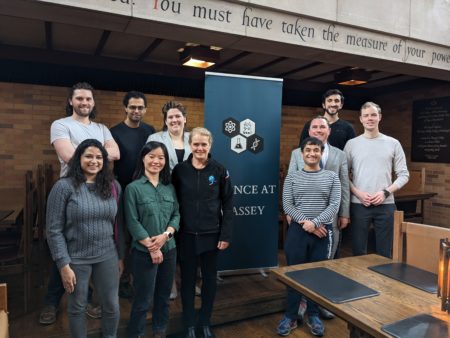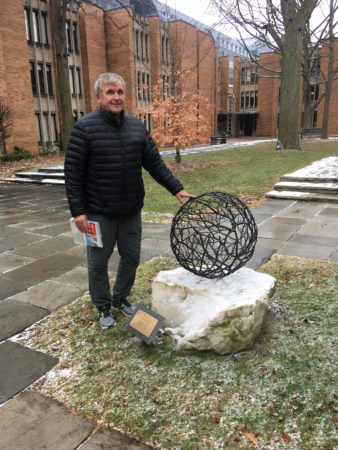In 1994–5, the last year of Saddlemyer’s mastership, one innovation was so popular that it immediately became a college tradition. This was the Murder Game, played in February when the stress of term work and the gloom of winter had become oppressive. Robertson Davies’s assessment was characteristically astute: he saw the game as creating a false tension during a period of real tension, a false tension whose arbitrary removal eased the real tension. It was introduced to the college by Kelli Shinfield (JF, 1994–6), then doing an MA in English and later married to Darren Novak (JF, 1995–8). Initially, she conceived this elaborate game of hide-and-seek as being focused on one person who was “it” or the “murderer,” “who would kill off the college members one by one or get accused first (but if a player made a false accusation they would be eliminated). Instead, it became a circular game, where every member who elected to play had a target to ‘kill’ while simultaneously being a target for someone else.” Shinfield recalls being “caught completely by surprise that anyone would object on moral grounds” and feeling “heartened by Master Ann Saddlemyer’s staunch defense of the game, letting people opt out.” She thought the game was eminently suited to a college whose residents were “so preoccupied with each other and inhabiting a perfect building in which to hide and hunt.” She also thought it would be a different (albeit slightly paranoid) way for people to relate to each other, [and] that it might create unusual and interesting friendships and alliances between people who would not otherwise get to know each other.” [Opening quotation mark absent —MPI] In her experience,
some of the quieter Junior Fellows turned out to be remarkably sneaky, aggressive and competitive, and those of us who were more outgoing tended to get knocked off early. Some students were passive, some were furious when eliminated. We speculated on who was holed up in their room stocked up on canned goods. Some people opted out and watched the rest cavorting with a sense of “what fools these mortals be” and some with great care and humor stalked their victims’ every move. It was a fabulous distraction from the dreary grey of February watching the remaining few tigers circle each other, each knowing the other’s identity, enlisting friends and acquaintances to help get their targets alone.
Marc Ozon, a resident junior fellow in 1994–6 and an early participant in the game, adds a few details:
It’s not to everyone’s taste, frankly. Some people took it very personally. One could opt out, but at the same time, it’s a small enough community that there’s an implicit peer pressure in comments like, “Come on, it’s only a bit of fun.” It is relatively innocuous, but there is a certain tension. You’re walking around; you could be “killed” at any point. As I recall, at the beginning of the game, each person drew the name of a victim. If a person was alone anywhere in the college, they could be “killed.” The idea was to continue “killing” without actually being a victim yourself. You inherited your victim’s victim. So A kills B, who was supposed to get C, so A then goes after C. You never quite knew who had whom. The game was very good at identifying those who had the time, energy, and competitive spirit to really throw themselves into it. There were accounts of people hiding out in hallways, around one of the corners, or in the shower. You can see why some people got a little up tight. So this is like sports, a way to blow off a bit of steam. It’s a bit of organized fun with people you know. Inevitably there’s someone who gets a little upset. It takes as long as it takes for the last person to be standing. My recollection is that it took about a week with the last day or two being just the last couple of people. There was also a rule whereby you had to kill someone once every twenty-four hours. If you’re just sitting and not doing anything about your prospective victim, a designated person can come and get you, and take you out of the game.
Grant, Judith Skelton. A Meeting of Minds: The Massey College Story. University of Toronto Press, 2015. p. 415–6
I don’t know about earlier, but by the time I played after 2012 there would always be two people alive at the end since they would close the circle and end up as one another’s targets. If there was a single winner, it was because they had the most points from kills and from any other bonuses awarded by the game administrators.
Related:


